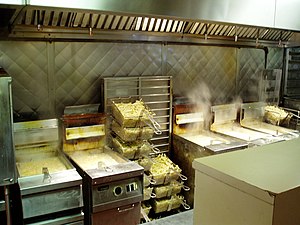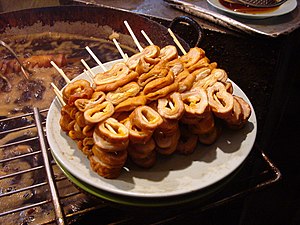Deep frying
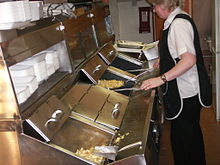
Deep frying (also referred to as deep fat frying) is a
The term "deep frying" and many modern deep-fried foods were not invented until the 19th century, but the practice has been around for millennia. Early records and cookbooks suggest that the practice began in certain European countries before other countries adopted the practice.
Deep frying is popular worldwide, with deep-fried foods accounting for a large portion of global caloric consumption.
History
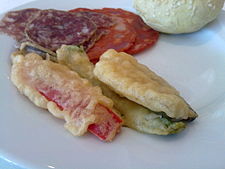
The English expression deep-fried is attested from the early 20th century.[4][5]
Deep-fried dough known as
French fries, invented in the late 18th century, became popular in the early 19th century western Europe.[11] In 1860, Joseph Malin combined deep fried fish with chips (french fries) to open the first fish and chip shop in London.[12]
Modern deep frying in the United States began in the 19th century with the growing popularity of
Technique

Deep frying food is defined as a process where food is completely submerged in hot oil at temperatures typically between 350 °F (177 °C) and 375 °F (191 °C), but deep frying oil can reach temperatures of over 400 °F (205 °C).[18] One common method for preparing food for deep frying involves adding multiple layers of batter around the food, such as cornmeal, flour, or tempura; breadcrumbs may also be used.[19]
While most foods need batter coatings for protection, it is not as necessary for cooked noodles and potatoes because their high starch content enables them to hold more moisture and resist shrinking. Meats may be cooked before deep frying to ensure that they are done inside while keeping juiciness.[20]
When performed properly, deep frying does not make food excessively greasy, because the moisture in the food repels the oil. The hot oil heats the water within the food, steaming it; oil cannot go against the direction of this powerful flow because (due to its high temperature) the water vapor pushes the bubbles toward the surface.[3][21] As long as the oil is hot enough and the food is not immersed in the oil for too long, oil penetration will be confined to the outer surface. Foods deep-fried at proper temperatures typically absorb "no more than a couple of tablespoons per 2+1⁄2 cups of oil" used.[22] This oil absorption rate is around the same as occurs with shallow frying,[22] such as in a pan.
However, if the food is cooked in the oil for too long, much of the water will be lost and the oil will begin to penetrate the food. The correct frying temperature depends on the thickness and type of food, but in most cases it lies between 350–375 °F (177–191 °C).[19][23] An informal test for a temperature close to this range involves adding a tiny amount of flour into the oil and watching to see if it sizzles without immediately burning. A second test involves adding one piece of food to deep fry and watching it sink somewhat and rise back up. Sinking without resurfacing indicates that the oil is too cold; not sinking at all indicates that the oil is too hot.[19]
It is recommended that deep fryers be cleaned often to prevent contamination.[24] The process of cooking with oil can also contaminate nearby surfaces as oil may splatter on adjacent areas. Oil vapors can also condense on more distant surfaces such as walls and ceilings. Supplies such as dish detergent and baking soda can effectively clean affected surfaces.[24]
Tools
Deep frying is done with a deep fryer, a pan such as a wok or chip pan, a Dutch oven, or a cast-iron pot. Additional tools include fry baskets, which are used to contain foods in a deep fryer and to strain foods when removed from the oil, and cooking thermometers, used to gauge oil temperature. Tongs, slotted spoons, wooden spoons, and sieves may be used to remove or separate foods from the hot oil.[25][26]
Japanese deep frying tools include long metal chopsticks; the agemono-nabe deep frying pot, which is heavy for retaining heat and deep for holding oil; the ami-shakushi net ladle used for scooping out batter debris; and the abura-kiri oil drying rack pan.[27]
- Deep frying tools
-
A deep fryer with slotted spoon, for removing foods from the hot oil
-
Slotted and perforated wooden spoons
-
Variousstrainers, including a spider, left
-
A strainer used in the preparation of empanadas
-
Anami shakushi is a Japanese ladle or scoop that may be used to remove small drops of batter during the frying of tempura.
Dishes, foods, and culture
This section needs additional citations for verification. (July 2021) |
Deep-fried foods are common in many countries, and have also been described as "a staple of almost all
In the United States, the Chicago Tribune notes that "you can deep fry almost anything".
-
French fries being cooked in a row of deep fryers
-
Deep-frying chicken in a pan
-
Deep-fried swordfish collar
-
Breaded, deep-friedcalamari
-
Deep fried chitterlings
Africa
In Northern Africa, deep-fried dishes are a part of the cuisine.[38] A common food in this region is the deep-fried fritter, also referred to as "sponges".[38] In East Africa deep fried food is common, cooked in cast iron or earthenware pots. Frying in batter is common. A Ugandan specialty is a kind of doughnut called Mandazi. In areas of Southern Africa, street foods include deep-fried potato and cassava chips.[39] Deep-fried foods in the country of South Africa include fish and chips, vetkoek and koeksisters,[40] among others.
Asia

Japanese tempura is a popular deep-fried food[41] that generally consists of battered and fried seafood and vegetables. Japanese deep-fried dishes, or Agemono, include other styles besides tempura, such as Karaage, Korokke, Kushikatsu, and Tonkatsu.
In areas of Southeast Asia such as Thailand, insects are commonly deep-fried for human consumption.[42] Western-style fast food items such as donuts, deep-fried chicken, and deep-fried potatoes are also becoming popular in Asia.[43]
In
Deep-fried fish,
Deep-fried sticks of dough, known as youtiao in Chinese, are eaten in many East and Southeast Asian cuisines.
In Hong Kong, deep-fried intestine of pigs is a popular food.[47]
In South Asia, popular deep fried snacks are samosa, jalebi, and pakora.
Europe
Many countries such as the United Kingdom use pure or hydrogenated rapeseed oil for deep-frying.[48] Fish and chips is a very popular deep-fried dish in England since it originated in London in the 19th century and became popular among the working class. Its popularity continues with 229 million portions of fish and chips being sold annually in England.[49]
There is an annual trade fair devoted to deep-fried foods called the International Symposium on Deep-Fat Frying which features discussions on deep fat frying as well as exhibitions by companies involved with the process.[50]
Belgian tradition requires French fries to be deep-fried in filtered fat of cattle, locally called blanc de boeuf or ossewit.
The Mediterranean diets traditionally use olive oil for deep-frying, which it is absorbed by the food in the process. Research indicates that
The deep-fried Mars bar originated in Scotland,[52] with The Carron Fish Bar in Stonehaven claiming to have invented it in the early 1990s.[53]
North America
In the United States, soybean oil is often used for deep-frying.[48] Beignets, originally a French dish, are a popular deep-fried pastry in the U.S. city of New Orleans. Deep-fried food has been a core part of the culture of the American South with many restaurants solely serving deep-fried foods. The owner of one such restaurant has said of deep-fried food that "in the South it's a way of life".[37] Fast food is one of the most common ways to consume deep-fried food in North America.
Novelty deep-fried foods are popular today in American
Deep-fried food contests are frequently held at fairs such as the
Oceania
Fish and chip shops in Australia may purvey several types of deep-fried foods, along with other food types.[59]
South America

The
Oil deterioration and chemical changes
This section needs additional citations for verification. (August 2021) |
Deep fat frying involves heating oil to temperatures in excess of 180 °C in the presence of moisture and air. These conditions can induce a series of complex chemical reactions which may impact the quality of both the food and the oil it is cooked in. Examples of different chemical reactions include the production of free radicals, oxidation, hydrolysis, isomerization and polymerization. The exact reactions are dependent upon factors such as the oil type, frying conditions, and food being cooked. When frying, water can attack the ester linkage of triacylglycerols, resulting in mono- and diglycerols, glycerol, and free fatty acids (a type of hydrolysis reaction). The aforementioned hydrolysis reaction is enhanced by the produced fatty acids and other low molecular weight acid compounds.[61]
Overheating or over-using the frying oil leads to formation of rancid-tasting products of oxidation, polymerization, and other deleterious, unintended or even toxic compounds[62] such as acrylamide (from starchy foods). Recent research suggests fat deterioration may be worse when fat or oil is fried with food than when fat or oil is tested on its own in a laboratory.[63] Deep-frying under vacuum helps to significantly reduce acrylamide formation,[64] but this process is not widely used in the food industry due to the high investment cost involved.
Some useful tests and indicators of excessive oil deterioration are the following:
- Sensory – darkening, smoke, foaming, thickening, rancid taste and unpleasant smell when heating. This is the most unreliable way to decide when to change oil because those are very individual factors and can depend on different causes.
- Testing strips – decide when to change oil depending on FFA (free fatty acids) only[65]
- Oil-tester – measurement tool to exactly define the point of change oil by TPM/TPC (Total polar material/compounds)
- Laboratory – triglycerides.
Instruments that indicate total polar compounds, currently the best single gauge of how deep-fried an object is, are available with sufficient accuracy for restaurant and industry use.
Hazards
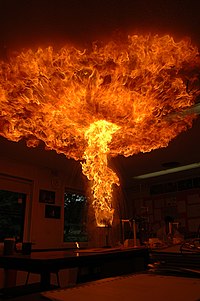
Cooking oil is not
Spilled hot cooking oil can also cause severe
Environmental

Deep frying produces large amounts of
The heating element in a deep fryer consumes enormous energy, electricity or otherwise. According to one source, an average home appliance deep fryer draws 2,000 watts.[78] Potatoes that are stored in artificially humidified warehouses contain more water, which makes the time required to deep fry them into chips longer. This increases the carbon dioxide footprint of commercially producing chips because more energy is required for frying over a longer time.[79]
Health
This section needs more primary sources. (October 2022) |  |
The process of deep frying food is generally detrimental to its nutritional value. The oils that foods absorb in their batter typically contain large amounts of saturated fats and trans fats. Consumption of large amounts of saturated and trans fats has been linked to a higher risk for some cancers.[80]
Eating deep-fried foods has also been linked to higher
Additionally, fat degradation processes (lipid peroxidation) during deep frying results in the loss of nutritional value in deep-fried foods.[83]
Cooking oil that has been used for too long may in addition cause blood pressure elevation and vascular hypertrophy.[84]
Trans fats are used in shortenings for deep-frying in restaurants, as they can be used for longer than most conventional oils before becoming rancid. In the early 21st century, non-hydrogenated vegetable oils that have lifespans exceeding that of the frying shortenings became available.[85] As fast-food chains routinely use different fats in different locations, trans fat levels in fast food can have large variations.[86] The amount of trans fat that is formed during frying appears to increase with frying temperature, frying time, oil oxidation, and oil reuse.[87]
Some studies have found that deep frying in olive and sunflower oils has been found to be less of a detriment to health and in some cases have positive effects on insulin levels.[81] Oil can be reused a few times after original use after straining out solids.[19] However, excessive use of the same oil can cause it to break down and release compounds into the food that may be carcinogenic, affect liver health, or influence the body's ability to absorb vitamins. Some European countries have set public health standards for the safety of frying oil.[88]
See also
References
- ISBN 978-0-7487-2566-3.
- ISBN 978-0-470-05232-7.
- ^ ISBN 978-1-4200-5559-7.
- ^ ""deep", adj". Oxford English Dictionary Online. Oxford University Press. Retrieved 24 May 2015.
- ^ ""deep", v.". Oxford English Dictionary Online. Oxford University Press. Retrieved 24 May 2015.
- ^ "Deep-Fried Foods". cooksinfo.com. Cooks Info. Retrieved 18 May 2015.
The ancient Greeks began frying foods in olive oil sometime around or after the 5th century BC. Frying foods in oil was common in Rome, certainly by the 1st century AD. Olive oil was mostly used, as it was plentiful. The Roman word was 'frigere.'
- ^ Lapetina, Adam (22 July 2014). "The true origins of 11 of your favorite fried foods". thrillist.com. Trillist. Retrieved 18 May 2015.
- ^ Antunes, Sonny. "Falafel, a dish the entire Middle East can agree on". finedininglovers.com. Fine Dining Lovers. Retrieved 18 May 2015.
- ^ Guttman, Vered (24 April 2012). "No matter where it originated, falafel is still Israel's national food". Haaretz. Retrieved 18 May 2015.
- ^ I. D., Morton. "Geography and history of the frying process". grasasyaceites.revistas.csic.es. Retrieved 18 May 2015.
- ^ "Who invented french fries? France and Belgium battle over who invented fried, crispy potato perfection". Daily News. New York. AFP RELAXNEWS. 1 January 2013. Retrieved 18 May 2015.
- ^ a b "The History of Fried Food". theex.com. Canadian National Exhibition. Retrieved 18 May 2015.
- ^ "'Old Salt' Doughnut hole inventor tells just how discovery was made and stomachs of earth saved." Special to The Washington Post; The Washington Post (1877–1954), Washington, D.C; 26 March 1916; p. ES9
- ^ "Onion Ring". ifood.tv. Retrieved 18 May 2015.
- ^ Moss, Robert. "How Cajun deep fried turkey took over America". seriouseats.com. Serious Eats. Retrieved 18 May 2015.
- ^ Neal, Rome (4 October 2002). "The science of corn dogs". CBS News. Retrieved 18 May 2015.
Corn dogs are a food that we know from fall festivals, carnivals and tailgating. It actually got its start when German immigrants moved into Texas. Some of these new German immigrants were sausage-makers by trade, but had a hard time selling their wares in Texas. So, as a ploy, they took sausages, rolled them in a cornbread batter and fried them. The sticks came later.
- ISBN 978-1-895451-21-4.
- ^ "Deep Fat Frying and Food Safety" (PDF). Retrieved 8 December 2020.
- ^ a b c d Bittman, Mark (21 October 2013). "Deep Fried and Good for You". The New York Times. Retrieved 22 May 2015.
- ISBN 978-1-930603-65-3.
- ISBN 978-0-231-13312-8.
- ^ ]
- ISBN 978-0-7432-7855-3. Retrieved 18 May 2015.
- ^ a b "How To Clean A Deep Fryer – Deep Fat Fryer Cleaning". deepfryerreviewsdepot.com. Deep Fryer Reviews Depot. Archived from the original on 10 May 2015. Retrieved 20 May 2015.
- ISBN 978-1-118-13076-6.
- ^ Dee Atkin. Delicious Deep Fried Recipes: Classic & Exotic Fried Chicken Recipes, Fried Rice Recipes, Fried Tofu Recipes, Fried Zucchini Recipes and More. p. 16. GGKEY:2LNT2E533SU.[permanent dead link]
- ISBN 978-4-7700-3049-8.
- ^ ISBN 978-1-136-81549-2.
- ^ "Deep frying". Cookingonline.com. Retrieved on 18 May 2015.
- ISBN 978-0-7611-7973-3.
- ISBN 978-1-56676-736-1.
- ^ Fantozzi, Joanna (9 October 2014). "Eating Deep-Fried Maple Leaves Is Big in Japan". ABC News. Retrieved 24 May 2015.
- ISBN 978-1-61069-233-5.
- ISBN 978-1-4053-8861-0.
- ]
- ^ "Photos: 75 deep fried foods". Chicago Tribune. 21 January 2015. Retrieved 22 May 2015.
- ^ ISBN 978-0313391989. Retrieved 24 May 2015.
- ^ ISBN 978-0-313-32956-2.
- ISBN 978-1-74059-545-2.
- ISBN 978-0-313-37627-6.
- ISBN 978-0-8048-3757-6.
- ^ Newman, Judith. What is fried and has six legs? Welcome to Insect Cuisine. The New York Times. 20 May 1992. Retrieved 23 May 2015.
- PMID 21547247.
- ^ "10 Most Popular Indonesian Deep-fried Dishes". www.tasteatlas.com. Retrieved 20 April 2022.
- ISBN 978-1607741411.
- ISBN 9781741047615.
- ^ "Hong Kong's best street food essentials". Time Out Hong Kong. Retrieved 6 May 2021.
- ^ ISBN 978-1-85573-556-9.
- ^ Zaino, Caitlin (19 April 2013). "Chipping away at the history of fish and chips". BBC. Retrieved 24 May 2015.
- ^ "8th International Symposium on Deep Frying Better understanding, better fried products 15–17 September 2015, Munich, Germany". eurofedlipid.org. Euro Fed Lipid. Archived from the original on 15 June 2015. Retrieved 12 June 2015.
- .
- ^ "Deep-fried Mars bars: no link with sudden stroke – Health News". NHS Choices. 10 July 2014. Archived from the original on 24 May 2015. Retrieved 24 May 2015.
- ^ "Deep-fried Mars bars disowned by chocolate firm". BBC News. 5 September 2012. Retrieved 24 May 2015.
- ^ Smith, Kevin (4 June 2012). "What Happens When You Deep Fry An iPad?". Business Insider. Retrieved 20 May 2015.
- ^ "Deep-Fried Gadgets: Artist Henry Hargreaves Deep-Fries (Fake) iPad, iPhone And More". The Huffington Post. 4 June 2012. Retrieved 24 May 2015.
- ^ Gamble, Cole (5 September 2012). "25 Deep-Fried Foods From the Texas State Fair". mentalfloss.com. Mental Floss. Retrieved 20 May 2015.
- ^ "Come fry with me". The Economist. 8 October 2009. Retrieved 20 May 2015.
- ^ "Deep Fried Masters". Discovery Networks. 12 July 2013. Archived from the original on 14 June 2015. Retrieved 23 May 2015.
- ISBN 978-0-7566-6082-6. Retrieved 23 May 2015.
- ISBN 978-1-60342-446-2.
- ^ Mariod, Abdalbasit; Omer, Nuha; Al, El Mugdad; Mokhtar, Mohammed (9 September 2014). "Chemical Reactions Taken Place During deep-fat Frying and Their Products: A review". Sudan University of Science & Technology SUST Journal of Natural and Medical Sciences. Supplementary issue: 1–17.
- ^ IARC Working Group on the Evaluation of Carcinogenic Risks to Humans (2010). Household use of solid fuels and high-temperature frying. Lyon, France; Geneva: Lyon, France : International Agency for Research on Cancer; Distributed by WHO Press, 2010.
- ^ BBC (London) undated Which oils are best to cook with?
- ^ Granda, C.; Moreira, R.G.; Tichy, S.E. (2004). "Reduction of Acrylamide Formation in Potato Chips by Low-temperature Vacuum Frying Journal of Food Science". 69 (8). Pages 405–411.
- ISBN 978-0-8493-6776-2.
- ^ "Chip pans". cambsfire.gov.uk. Cambridgeshire Fire and Rescue Service. Archived from the original on 20 May 2015. Retrieved 20 May 2015.
- ISBN 978-1-86891-824-9.
- ISBN 978-0-88862-596-0.
- ISBN 978-1-86891-824-9.
- ISBN 978-1-59955-765-6.
- ISBN 978-0-544-18655-2.
- ^ ISBN 978-1-58890-161-3.
- ^ Anderson, L. V. (April 2015). "The Technique That Will Make You Want to Batter and Fry Everything". slate.com. Retrieved 31 July 2015.
- ^ ISBN 978-0-8118-6379-7.
- ]
- ^ Carman, Tara (21 May 2015). "Grease, wet wipes clog Metro Vancouver's sewers". The Vancouver Sun. Archived from the original on 8 November 2020. Retrieved 30 May 2015.
- ISBN 978-1-4358-3584-9.
- ISBN 978-1-933392-72-1.
- ^ Murray, Sarah (14 December 2007). "The Deep-Fried Truth". The New York Times. Retrieved 22 May 2015.
- ^ "Study finds eating deep-fried food is associated with an increased risk of prostate cancer". fredhutch.org. 28 January 2013. Retrieved 19 May 2015.
- ^ a b Davis, Robert. "Health Risks of Fried Foods May Be Overblown". Time. Retrieved 19 May 2015.
- ^ "Can eating burnt foods cause cancer?". Cancer Research UK. 15 October 2021.
- S2CID 883176.
- ^ "Chun-Yi Ng, Yusof Kamisah, Othman Faizah, & Kamsiah Jaarin, 2013 Recycled Deep-frying Oil Causes Blood Pressure Elevation and Vascular Hypertrophy in Sprague-Dawley Rats 1(1) : 2-6". Archived from the original on 9 October 2016.
{{cite journal}}: Cite journal requires|journal=(help) - ^ NYC Board of Health. "Board of Health Approves Regulation to Phase Out Artificial Trans Fat: FAQ". Archived from the original on 6 October 2006. Retrieved 7 January 2007.
- PMID 16611965.
- PMID 27374582. Retrieved 2 March 2021.
- ^ Ogilvie, Megan (10 October 2014). "Deep fried food may be worse for you than you think". The Toronto Star. Retrieved 23 May 2015.
Further reading
- Erickson, M.D. (2007). Deep Frying: Chemistry, Nutrition, and Practical Applications. AOCS Press. ISBN 978-1-893997-92-9. 447 pages.
- Kosa, Frank (16 October 2006). "Backstory: If you can think of it, he can deep fry it". The Christian Science Monitor. Retrieved 18 May 2015.
External links
 Media related to Deep frying at Wikimedia Commons
Media related to Deep frying at Wikimedia Commons Deep Fat Frying at the Wikibooks Cookbook subproject
Deep Fat Frying at the Wikibooks Cookbook subproject







